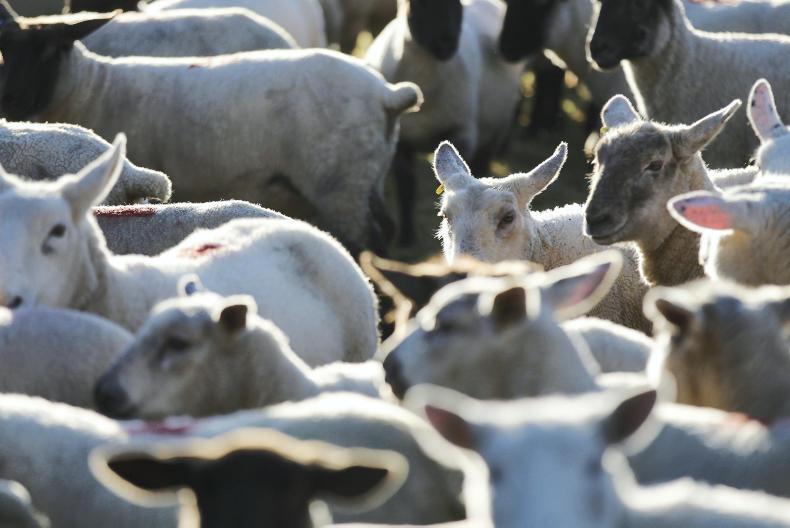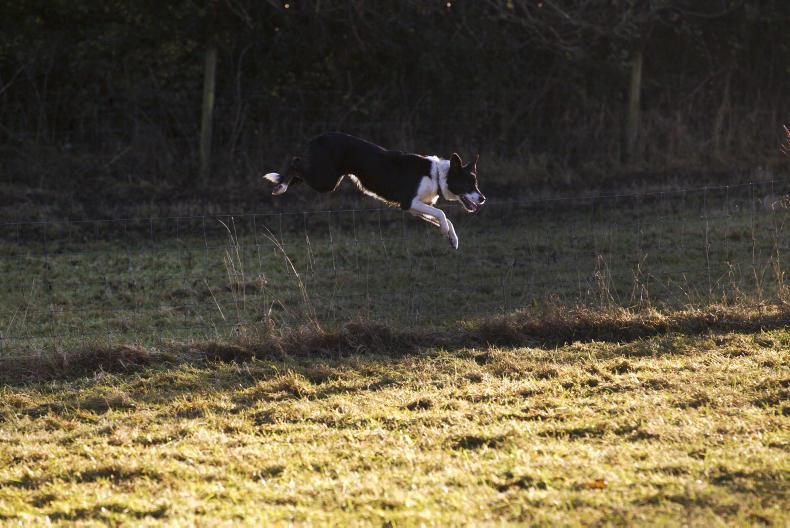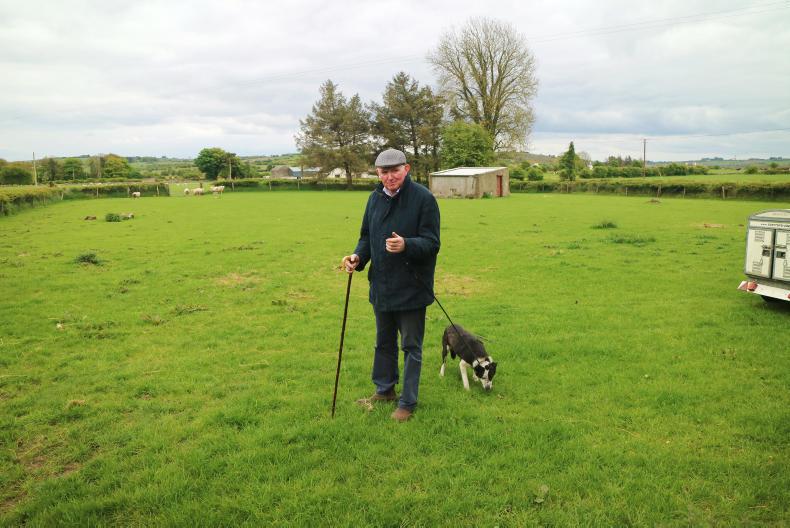The difference between a successfully trained sheepdog and a dog that doesn’t make the grade is often down to the operator training and handling the dog. This was the assessment of Eamonn Egan, a well-experienced dog trainer who operates Rockland Sheep Dog Training between Taughmaconnell and Ballinasloe on the Roscommon/Galway border.
Eamonn’s sheepdog training enterprise is different from the norm in that he trains the handler how to train and work with their dog. He gave a demonstration at a Roscommon Lamb Festival organised farm walk last Friday on the farm of Willie John Fitzmaurice at Lisnacella, Athleague, Co Roscommon.
Eamonn’s advice has been featured in the past in the Irish Farmers Journal and provides some really useful tips for sheepdog handlers. The first is to walk before you can run with the advice to nurture the dog’s interest and ability rather than trying to "move mountains" on the first day.
For young dogs, working with sheep that are accustomed to being flocked is a must, as is working in a confined area.
Getting started
The starting point can often be in a penned area to get a dog accustomed to seeing and being around sheep, increasing to a small paddock that is well fenced.
Eamonn says there are three main points that make a dog/bitch suitable for training: friendliness, a good dog-trainer bond and breeding.
“I want a dog to be friendly, not shy – one that will come to me when I call it. I’d always stay away from nervous dogs. They are difficult to train," he says.
"Basically, just pick one you like as you’ll work better together if you like them. Obviously breeding is very important as well. Purchase a pup from good working parents, preferably ones registered with the International Sheepdog Society.”
Getting a dog used to people is vital for success in later life and particularly important if it will be handled by more than one person.
He says that if you have them from birth, be sure pick them up and familiarise them with you at least twice a week.

Secondly, you can get them familiar with the sheep before training begins to gauge their reaction. Dogs differ in how quick they show interest. Some show it at three to four months of age while for others it takes much longer. Using a long, light lead while around dry ewes or hoggets which are also used to being worked by dogs works best for this.
Stay away from ewes and young lambs as the first inclination of the ewe is to protect her young, which may end up with a young dog getting hurt or scared.
Bad habits
Eamonn stresses two key points for handling young dogs: “Never give a command when the dog is not in the position to react to it. A lot of dogs have bad habits picked up at a younger age and become a lot harder to train.
"Most important is not having a young dog let loose with access to animals on its own as they will learn to be around stock for their own benefit rather than yours. This way they will know and learn they are only supposed to work with the animals when you’re around.”
As part of the training course, Eamonn uses five simple commands to get dogs working to their full potential. “Here” is the first and most basic to encourage the dog to come to the handler. Followed by the “sit/lie down” command.
For movement around the sheep, two commands are used: “away” to go right and “come by” to go left. “Go right” and “keep left” can also be used. Lastly, the command “walk on” is used for getting the dog to follow the sheep and keep them straight.

Praise the good work
When a dog responds to the commands correctly, praise is essential for the continued progression of the training programme. Eamonn says how you talk and body movements also play a big part in the correct training of dogs.
Tone of voice is not only important for giving praise but for determining speed as well
"A longer tone for commands gets the dog to go slower while the sharper, quicker command will get the dog to speed up. In training, if you give a command for the dog to go right, you have to be in a position to put pressure on the dog to go right. Body language and practice are important for recognition of commands. With plenty of practice, you will hardly have to look at them and they’ll know what to do.”
Eamonn explains that usually by the third day of training: “The dog and the handler have acquired the skill to work sheep in a controlled manner, using proper commands and working the dog in a way they have never worked before.”
This depends, as mentioned above, on the dog being ready to work, with some taking longer to show interest.
Training the handler
The last point Eamonn makes is that more often than not it is the handler who needs to learn. Therefore, it is well worth getting the proper training as you could have a dog with good potential and the ability to work, but the handler may need a few tweaks in performance to get the best out of the dog.
More information can be found here
Read more
Two-tonne ewe and lamb opens Roscommon festival
Watch: transformed grass-based system in Co Westmeath
The difference between a successfully trained sheepdog and a dog that doesn’t make the grade is often down to the operator training and handling the dog. This was the assessment of Eamonn Egan, a well-experienced dog trainer who operates Rockland Sheep Dog Training between Taughmaconnell and Ballinasloe on the Roscommon/Galway border.
Eamonn’s sheepdog training enterprise is different from the norm in that he trains the handler how to train and work with their dog. He gave a demonstration at a Roscommon Lamb Festival organised farm walk last Friday on the farm of Willie John Fitzmaurice at Lisnacella, Athleague, Co Roscommon.
Eamonn’s advice has been featured in the past in the Irish Farmers Journal and provides some really useful tips for sheepdog handlers. The first is to walk before you can run with the advice to nurture the dog’s interest and ability rather than trying to "move mountains" on the first day.
For young dogs, working with sheep that are accustomed to being flocked is a must, as is working in a confined area.
Getting started
The starting point can often be in a penned area to get a dog accustomed to seeing and being around sheep, increasing to a small paddock that is well fenced.
Eamonn says there are three main points that make a dog/bitch suitable for training: friendliness, a good dog-trainer bond and breeding.
“I want a dog to be friendly, not shy – one that will come to me when I call it. I’d always stay away from nervous dogs. They are difficult to train," he says.
"Basically, just pick one you like as you’ll work better together if you like them. Obviously breeding is very important as well. Purchase a pup from good working parents, preferably ones registered with the International Sheepdog Society.”
Getting a dog used to people is vital for success in later life and particularly important if it will be handled by more than one person.
He says that if you have them from birth, be sure pick them up and familiarise them with you at least twice a week.

Secondly, you can get them familiar with the sheep before training begins to gauge their reaction. Dogs differ in how quick they show interest. Some show it at three to four months of age while for others it takes much longer. Using a long, light lead while around dry ewes or hoggets which are also used to being worked by dogs works best for this.
Stay away from ewes and young lambs as the first inclination of the ewe is to protect her young, which may end up with a young dog getting hurt or scared.
Bad habits
Eamonn stresses two key points for handling young dogs: “Never give a command when the dog is not in the position to react to it. A lot of dogs have bad habits picked up at a younger age and become a lot harder to train.
"Most important is not having a young dog let loose with access to animals on its own as they will learn to be around stock for their own benefit rather than yours. This way they will know and learn they are only supposed to work with the animals when you’re around.”
As part of the training course, Eamonn uses five simple commands to get dogs working to their full potential. “Here” is the first and most basic to encourage the dog to come to the handler. Followed by the “sit/lie down” command.
For movement around the sheep, two commands are used: “away” to go right and “come by” to go left. “Go right” and “keep left” can also be used. Lastly, the command “walk on” is used for getting the dog to follow the sheep and keep them straight.

Praise the good work
When a dog responds to the commands correctly, praise is essential for the continued progression of the training programme. Eamonn says how you talk and body movements also play a big part in the correct training of dogs.
Tone of voice is not only important for giving praise but for determining speed as well
"A longer tone for commands gets the dog to go slower while the sharper, quicker command will get the dog to speed up. In training, if you give a command for the dog to go right, you have to be in a position to put pressure on the dog to go right. Body language and practice are important for recognition of commands. With plenty of practice, you will hardly have to look at them and they’ll know what to do.”
Eamonn explains that usually by the third day of training: “The dog and the handler have acquired the skill to work sheep in a controlled manner, using proper commands and working the dog in a way they have never worked before.”
This depends, as mentioned above, on the dog being ready to work, with some taking longer to show interest.
Training the handler
The last point Eamonn makes is that more often than not it is the handler who needs to learn. Therefore, it is well worth getting the proper training as you could have a dog with good potential and the ability to work, but the handler may need a few tweaks in performance to get the best out of the dog.
More information can be found here
Read more
Two-tonne ewe and lamb opens Roscommon festival
Watch: transformed grass-based system in Co Westmeath







SHARING OPTIONS